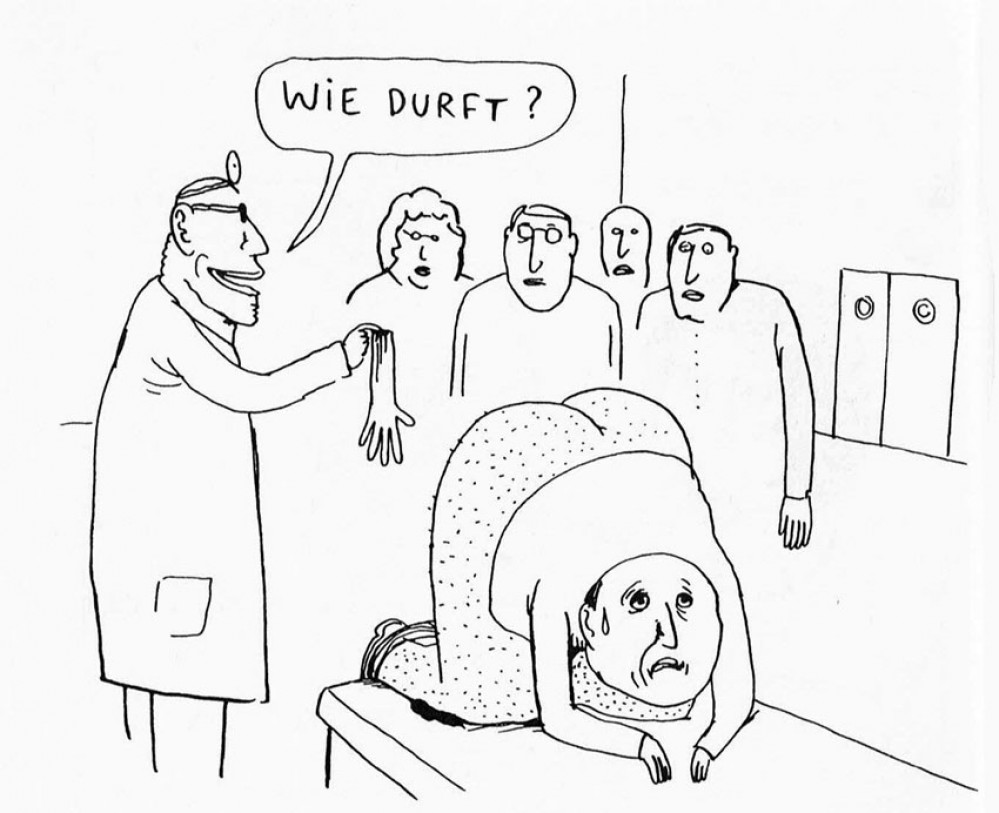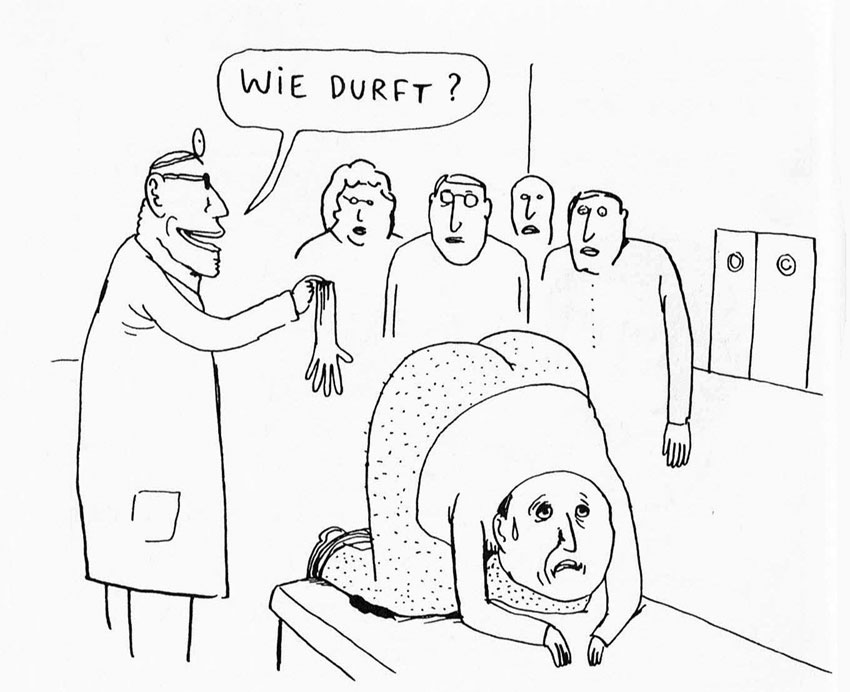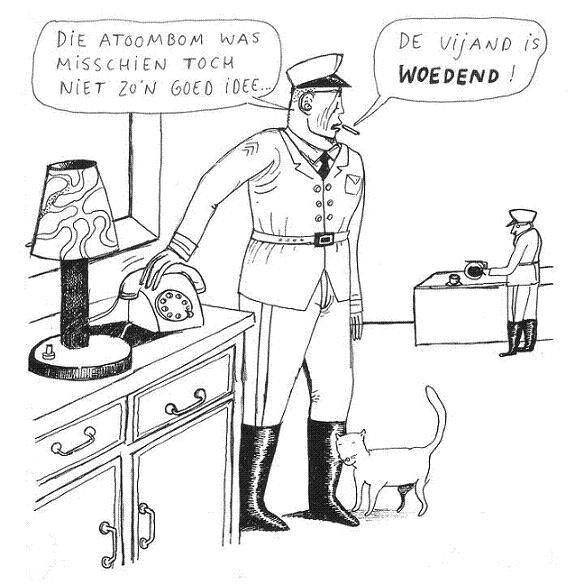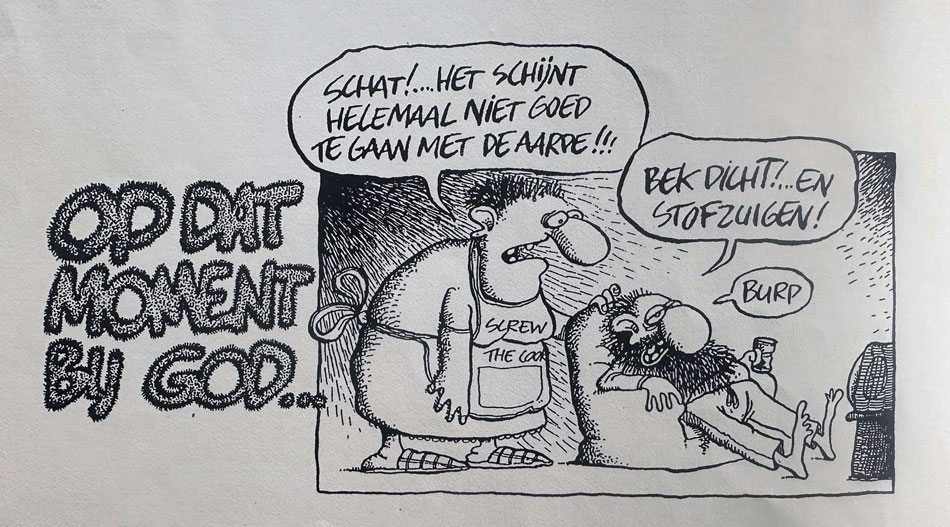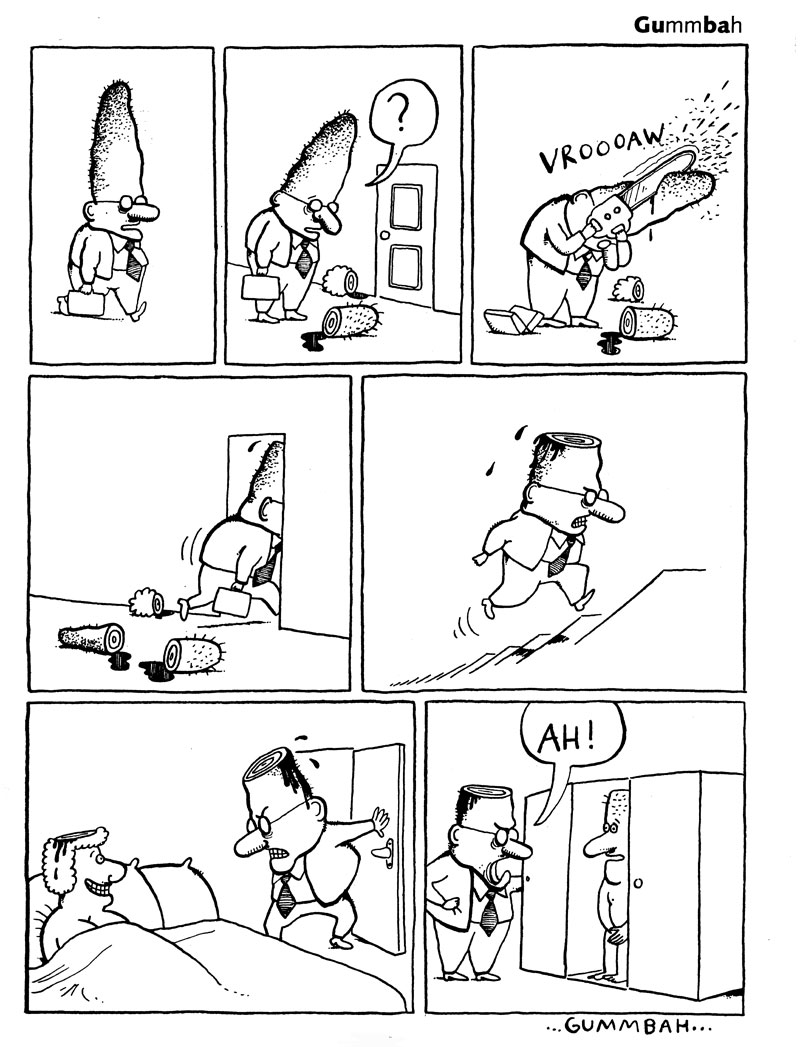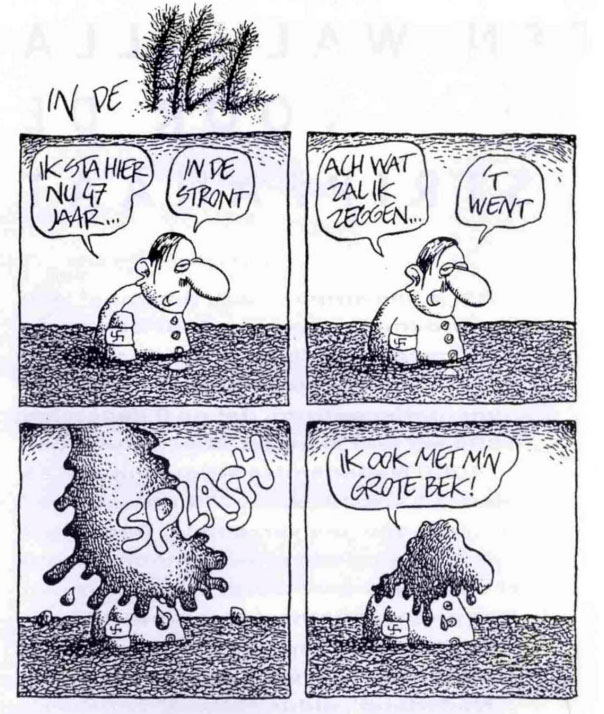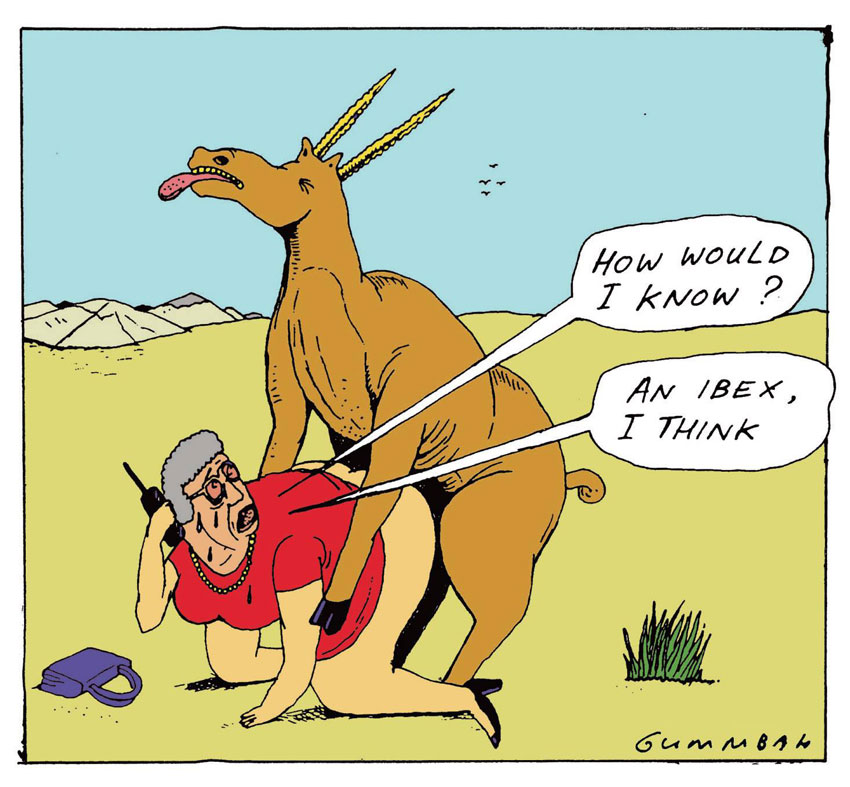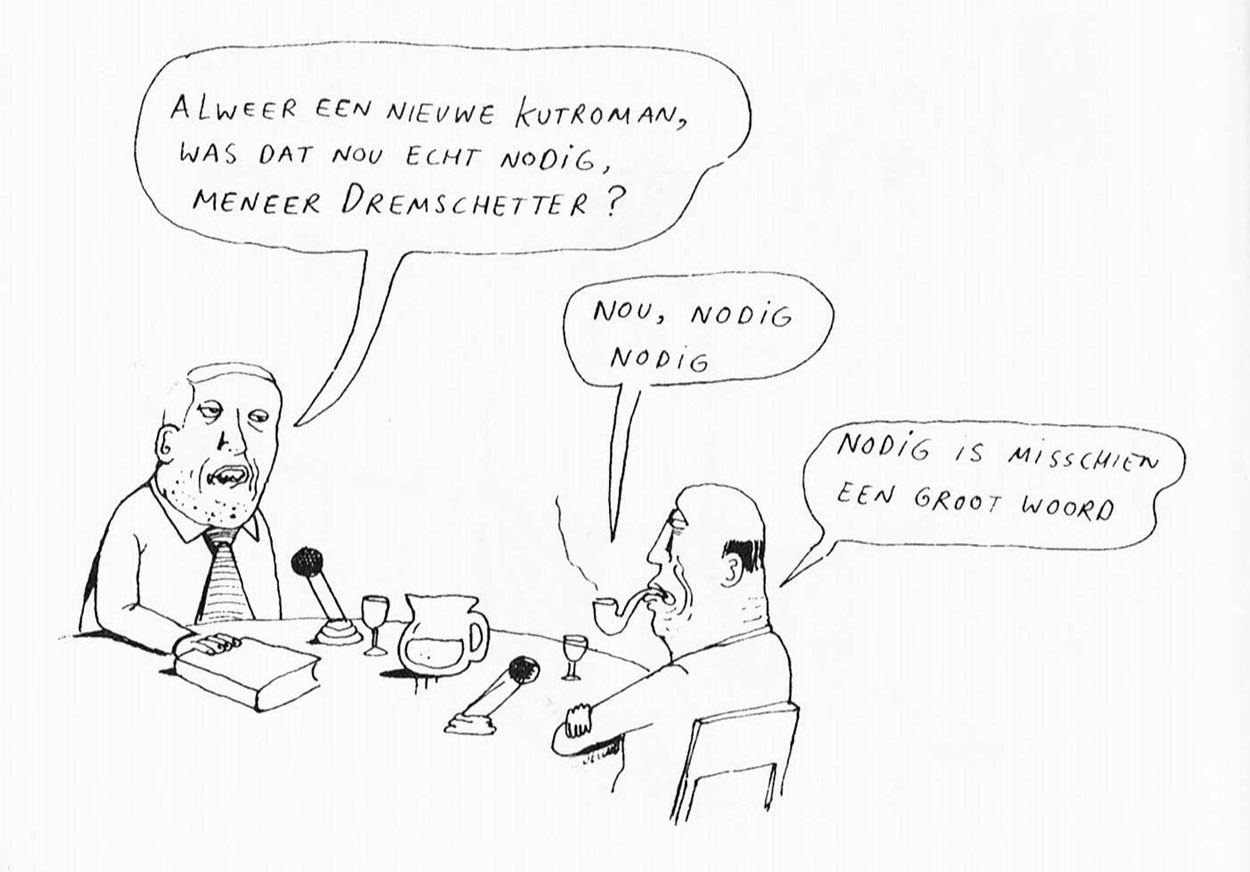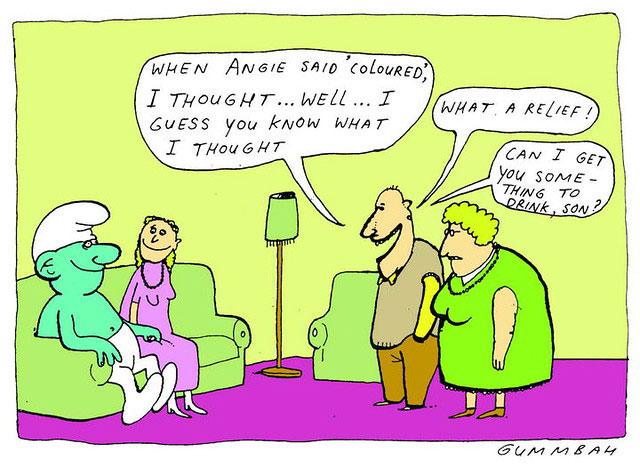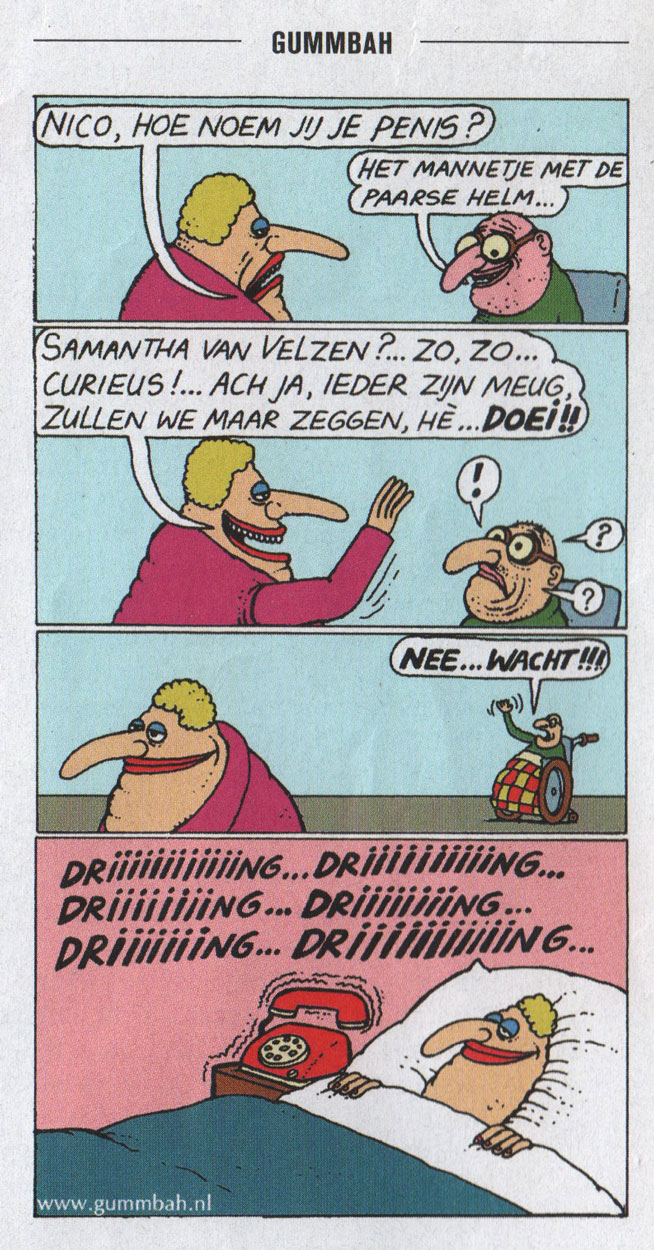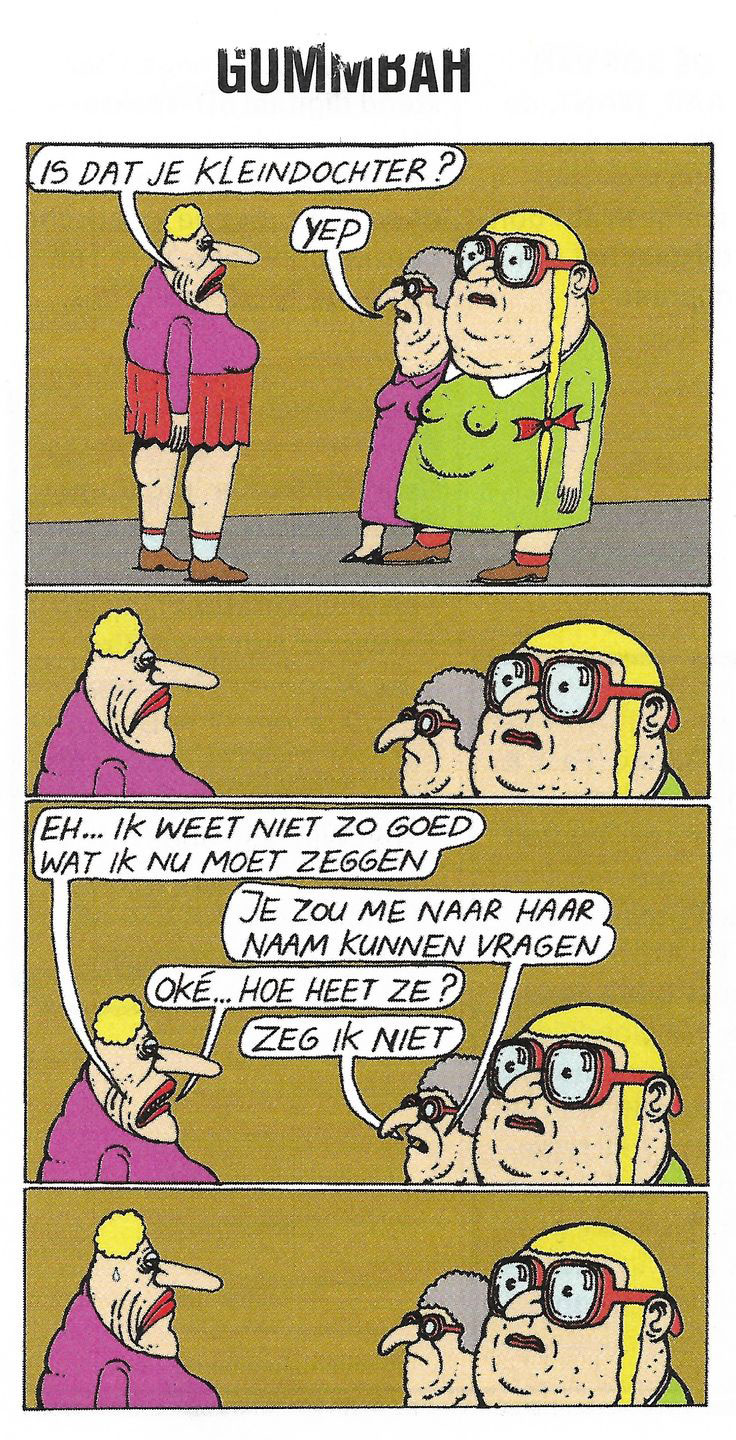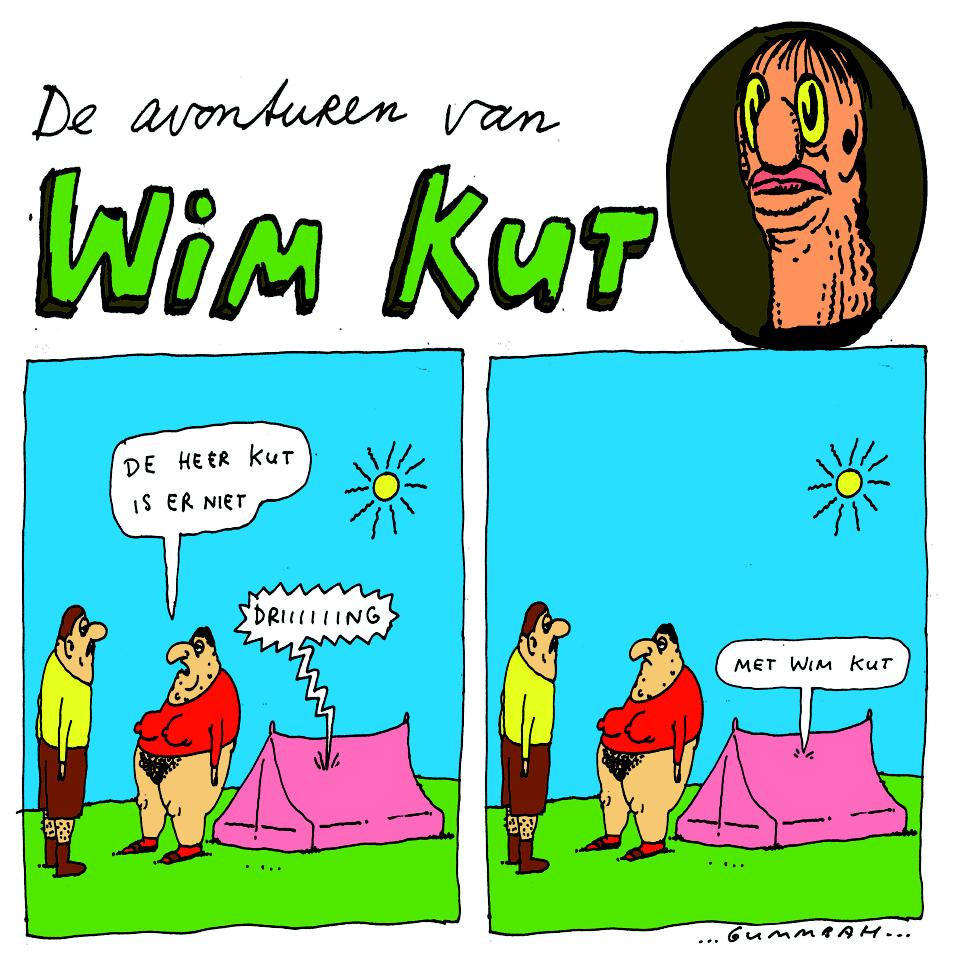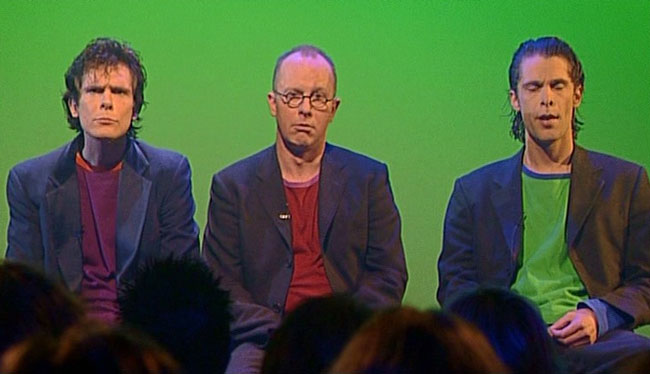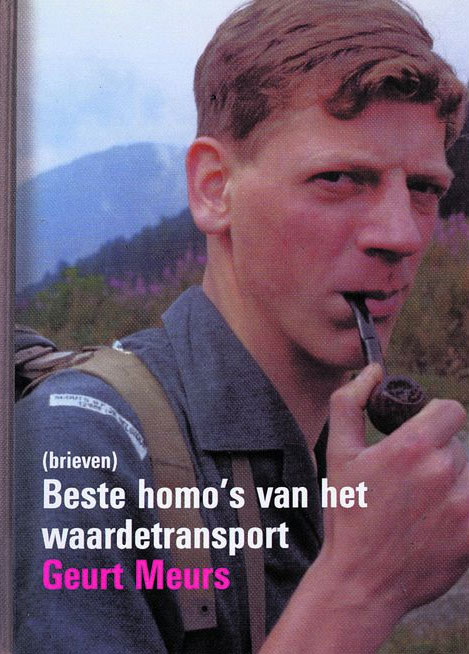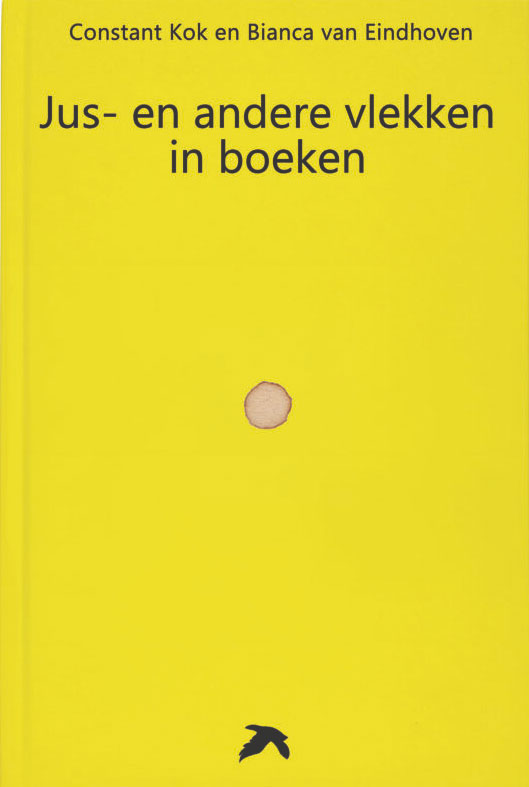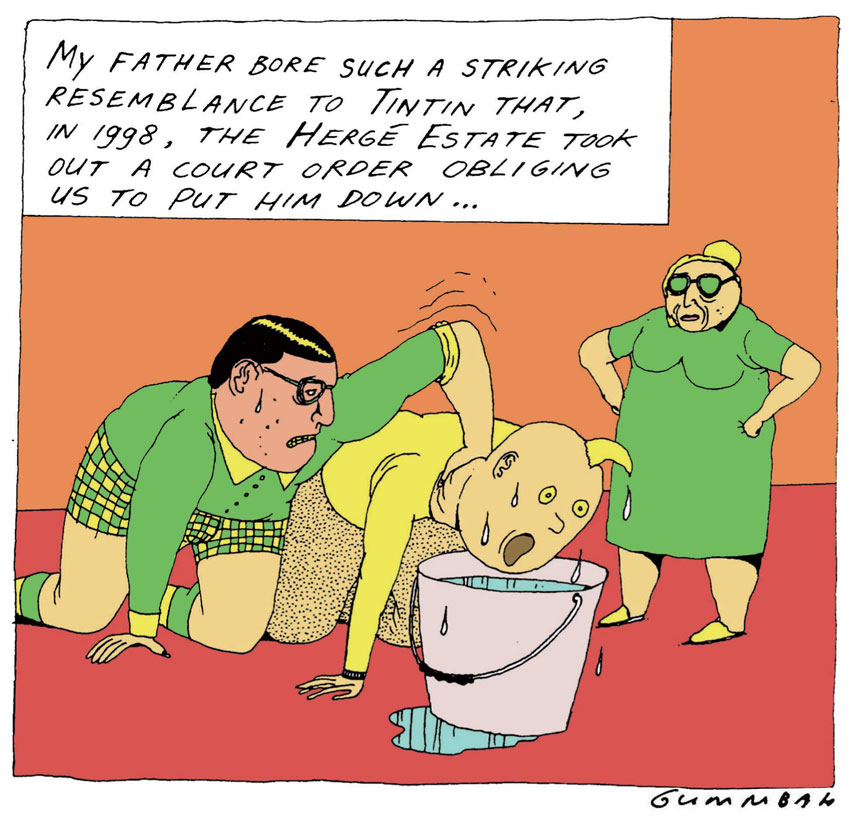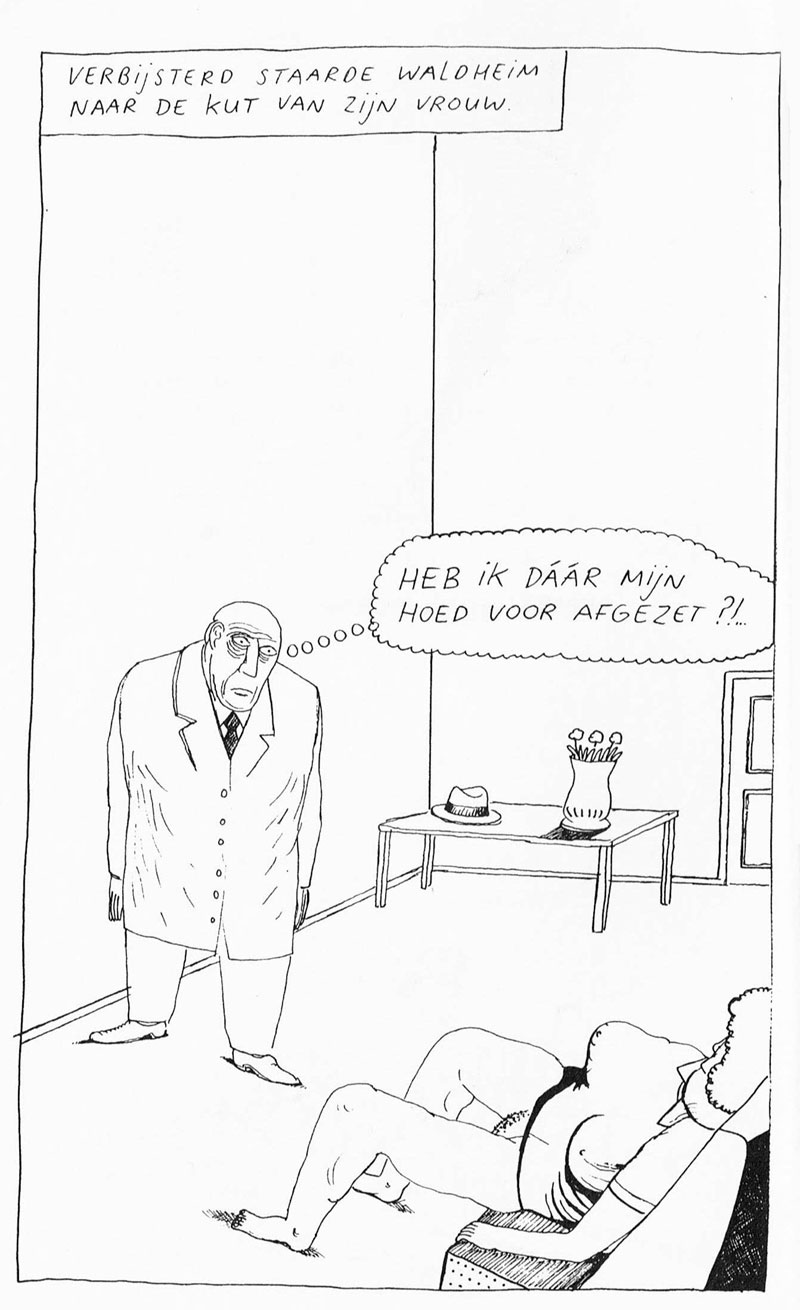Gummbah is a Dutch cartoonist, notorious for his dry, absurd and often offensive black comedy, which earned him a cult following. Gummbah's universe is surreal, filled with ugly, frustrated and nihilistic people, who express their viewpoints in dry, literary language and buzz words. Among the few recurring characters are the cynical woman Deirdre and the anthropomorphic pig Fout Varken. Gummbah has also been active in other media. He was co-founder and regular contributor to the small press magazine De Bedenkelijk Kijkende Grondeekhoorn ("The Worried Looking Ground Squirrel", 1996-2001) and its spin-off organization Bond Tegen Humor ("Society Against Humor"). Together with comedians Hans Teeuwen and Pieter Bouwman, Gummbah wrote and performed the theatrical comedy show 'Poelmo, Slaaf Van Het Zuiden'. He has additionally made paintings, designed T-shirts with bizarre slogans and created slide presentations of non-existent books with ludicrous titles and even stranger story outlines.
"That atom bomb wasn't such a good idea after all... the enemy is FURIOUS!"
Early life and career
Gummbah was born in 1967 as Gertjan van Leeuwen in Nieuwaal, a small village in the province of Gelderland. He has two sisters and a brother, but also two brothers who had died young, even before he was born. Van Leeuwen was informed about his "ghost siblings" at an early age. It made him aware that life can be brutal and death very sudden. Since he was raised in a reformed religious environment, the boy was frightened of going to Hell. Van Leeuwen enjoyed drawing as a child, even when he wasn't allowed to. Whenever he lacked pen and paper he simply made drawing movements in the air. Most children felt he was weird and as an adult he often described himself as a "slow, dumb pupil who didn't know what he wanted to do." Van Leeuwen credited his mother with helping him find his life path. As a teenager he attended art school, but only for one day, since he didn't like drawing from nature. He vastly preferred using his own imagination.
Van Leeuwen began his working life employed by a gardener. Later he worked for a curtain company, where he moved up the ladder to become head of the stockroom. At his mother's suggestion, Van Leeuwen studied journalism at the Academy of Journalism (nowadays the Fontys Academy of Journalism) in Tilburg. As he was too shy for the job, his journalistic career went nowhere. He once travelled to Poland, where he interviewed Jerzy Urban, the spokesman for the communist Council of Ministers (1981-1989) and president/dictator Wojciech Jaruzelski. Although Gummbah thought he had an exclusive interview in his hands, no Dutch magazine was interested in publishing it, since Urban had visited the Netherlands two months earlier and had already been interviewed by every major paper at that occasion.
As a teenager, Van Leeuwen lost his religious fears, and developed a love for brutal and absurd comedy. His favorite novelists are Nikolai Gogol, Daniil Charms, Jan Cremer, A.L. Snijders and Gerard Reve. In terms of comedy he admires Laurel & Hardy, The Marx Brothers, Monty Python, Arjan Ederveen and Jiskefet. He also enjoyed David Lynch's 'Twin Peaks', "except for the Log Lady". Among his graphic influences are painters like Hieronymus Bosch and Salvador Dalí and comic artists such as André Franquin, Kamagurka, Gotlib, Jean-Marc Reiser, Édika, Robert Crumb, Hein de Kort, Eric Schreurs and Peter van Straaten. Especially Kamagurka, Hein de Kort and the cartoonists from Fluide Glacial and Charlie Hebdo have convinced him that a virtuoso drawing style wasn't necessary to entertain readers.
Early Gummbah cartoon, from God #1 (1993).
Comics and cartoons
In the early 1990s, Gertjan van Leeuwen was watching a TV interview with the rock star Iggy Pop, who used a strange word he hadn't heard before, "gumba". Van Leeuwen had no idea what it meant, but assumed it meant "bastard" or another pejorative term. It nevertheless sounded good enough to adapt as his pseudonym, writing the word as "Gummbah" and adding three dots in front and behind the word. Much to his disappointment, he later found out "gumba" was Anglo-Italian slang for a "good, loyal friend". Gummbah applied to many magazines, but his work only ran in a few obscure Dutch alternative magazines.
Gummbah strip published in Zone 5300 #7 (April 1995).
Fed up with being rejected he decided to launch his own comic magazine, and in 1993 he published the first issue of God. He gave each comic book store a copy and sent one to publishing house De Harmonie. He never had to create a second issue, because De Harmonie actually offered him a contract. Since then, De Harmonie has published most of Gummbah's books, which carry surreal titles like 'De Verbaasde Analfabeet' ("The Astonished Illiterate", 1994), 'De Verdwenen Titel' ("The Lost Title", 1995), 'Hoe Eddie in Balbezit Kwam' ("How Eddie Got Possession of the Ball", 1997), 'De Tijd Vliegt Slecht' ("Time Flies Bad", 1998), 'Het Geheim van het Verdwenen Mysterie' ("The Secret of the Lost Mystery", 1999) and 'Een Kalfslederen Onderbroek Om U Tegen Te Zeggen' ("Calfskin Underpants To Die For", 2001).
From: 'De Verbaasde Analfabeet' (1994), depicting Adolf Hitler in Hell. Translation: "I've been standing in shit for 47 years. Ah, you get used to it, I'll say... Me and my big mouth!".
Gummbah's career finally took off and soon his cartoons appeared in Incognito, De Volkskrant, Nieuwe Revu, Boekblad, Cabaret, Zone 5300, Sick and Propria Cures. In Belgium they could be found in Humo, in Germany in Titanic and in England in Prospect. In 2008, Gummbah released his first English-language book: 'Meanwhile, Between Two Eternities of Darkness' (De Harmonie, 2008).
Style
Gummbah is infamous for his dry and nihilistic comedy. His characters are grotesque, pathetic and lonely, drawn with large heads, podgy or scrawny bodies, zits and warts. His men, women and children find themselves in embarrassing, horrible situations. Their conversations are awkward, their work and hobbies pointless. If they have a sex life they require strap-ons, blow-up dolls and icky pornography. Most suffer or are on the verge of death. Many are desperate or apathetic. Gummbah pokes fun at junkies, pedophiles, rape victims, terminally ill patients and especially the (mentally) handicapped, although his favorite targets are pseudo-intellectuals, novelists and the art world. He despises cliques where people group together to find themselves better than everybody else. Especially in the literary world and museums, bad writers and artists are sheltered by yes-men and people who blindly believe in their artistic importance. Usually it has more to do with basking in their glow than genuine admiration. According to Gummbah, most "serious literature" is actually written by whiny, self-important posers, and he loves to ridicule such people. In many of his cartoons pretentious novelists discuss their books with a publisher or a literary critic. In others, museumgoers try to make sense of modern art.
"Yet another shit novel, was that really necessary, mister Dremschetter?" "Well, necessary, necessary..." "Necessary is a big word."
Much of Gummbah's comedy comes from the dialogues. His characters express themselves in very cultivated language, using literary expressions and cultural buzzwords in highly inappropriate situations. This unrealistic "natural" language provides an ironic contrast. Other characters give dry, cold, disinterested commentary on other people's happiness and misery. Gummbah often uses old-fashioned words and archaic expressions in real life, a comedic trait he inherited from his father. He picks up lines from novels or casual remarks heard in the street. Interviewed by Rutger Lem on the website hardhoofd.com (22 December 2010), Gummbah explained that reality is absurd. People use language to describe reality, but it rarely syncs up. Most of the time it clashes or doesn't make sense. That's what, to him, makes language so funny and fascinating.
Cartoon by Gummbah.
Most of Gummbah's cartoons and comics lack recurring characters. Some of the few are Deirdre, Fout Varken, Wim Kut, Clown Johan and Beer Wijnand. Deirdre is a cynical, big-nosed, double-chinned obese woman, who usually talks with people she couldn't care less about. Another misanthropic character is Fout Varken ("Wrong Pig"), a pig in a suit. The eternally uninterested Wim Kut (literally: "Wim Cunt") is often portrayed on holiday, or in bars or restaurants, where he's clearly not enjoying himself. Clown Johan is a clinic clown who hates his job. In one cartoon, when confronted with a sick child, he bluntly remarks: "Do you mind that I'm really not going to put any effort into this?". Beer Wijnand is an anthropomorphic bear who is very direct in expressing his anger and disgust.
Gummbah's work has also featured cameos from characters from child-friendly media. The most frequent guest appearances are made by Walt Disney's Mickey Mouse, Willy Vandersteen's Wiske or Peyo's Smurfs, who are all depicted as unshaven, chain smoking grouches. Most of Gummbah's comics are drawn by hand, others are parody collages. Sometimes, he picks out comic panels or photos by other artists and then adds in new, absurd speech balloons of his own. He is additionally active as a painter. 89 reproductions of his paintings were compiled in the book 'From the Bottomless Pit' (Pantofle Books, 2019).
Deirdre gags from Humo magazine. Translation: "Nico, what do you call your penis?" - "The man with the purple helmet..." - "Samantha Van Velzen? Well, well, strange! Ah well, each to his liking, we shall say, ... Bye!!" - "No... wait!!!". Translation of the second cartoon: "Is that your grandchild?" - "Yep." - "Eh... I really don't know what to say now." - "You could ask me what her name is." - "O.K., what's her name?" - "I won't say."
Controversy
Throughout the years, Gummbah's strange and taboo-breaking cartoons have often confused and upset people. Once, a woman complained to De Volkskrant that "Gummbah made her long for the days of Marten Toonder's Olivier B. Bommel." Writing to Humo magazine, one man felt so offended by Gummbah's vulgarity that he dared the cartoonist to "come to his house, so he could rub him in with feces from top to toe." A week later Gummbah replied with a comic strip in which he visited the reader, asking him to fulfill his promise of "rubbing him in with feces". The startled reader then shouts: "Look... I don't have that much shit in the house!" and slams the door. The final panel shows Gummbah walking away disappointed, muttering: "Promises, promises." Another time he drew a cartoon about a loser novelist named Henk Bok. Much to Gummbah's surprise he received an angry letter from a real-life Frysian novelist with that particular name who thought the cartoon was a personal attack.
Interviewed by Humo (issue #3043, 29 December 1998), Gummbah explained that he has a sadistic sense of humor. He is fascinated with filth and deformities and so enjoys drawing unattractive, unsympathetic and downright repellent people. The cartoonist also pointed out that he doesn't make these things up. In his opinion most people are ugly by nature, so inspiration is never far away. To him handicapped people are a "funny sight" and most people who have a handicap can laugh with themselves: "Usually persons who have to push handicapped people in their wheelchairs are the ones who feel more offended." According to Gummbah, people identify themselves with a certain kind of decency, norms and rules: "when you challenge this, you threaten their identity, which frightens and angers them." The cartoonist also stressed that he does care about life's tragedies. He, for instance, is a member of the World Wildlife Fund. Some real-life miseries are even so depressing to him that he deliberately ignores them. But, like he once explained, rather than hang yourself in utter despair, it's better to laugh at it.
Early in his career, Gummbah was also criticized for being a rip-off of Kamagurka. Both cartoonists draw absurd, vulgar gags in a simple, black-and-white drawing style. Particularly when Gummbah published in Kamagurka's house magazine Humo, such comparisons were unavoidable. Even Kamagurka himself called him a copycat. While Gummbah acknowledged Kamagurka's influence in the aforementioned 1998 Humo interview, he pointed out that Kamagurka didn't invent absurd comedy and was likewise inspired by the cartoonists in the French magazine Hara-Kiri/Charlie Hebdo. He also concluded that drawing isn't a competition about "Who came first?".
'Wim Kut'. Translation: "Mr. Kut isn't here." - "DRIIIIIING! Wim Kut here."
De Bedenkelijk Kijkende Grondeekhoorn
In 1996, Gummbah teamed up with his fellow Tilburg graphic artists and humorists Ivo van Leeuwen, Steppie Lloyd Trumpstein and Jeroen de Leijer. On 1 October of that year, they established their own small press magazine De Bedenkelijk Kijkende Grondeekhoorn ("The Worried Looking Ground Squirrel", 1996-2001) through their own imprint Nooitgelezen ("Neverread"). The publication was a vehicle for all the work that their regular editors rejected, most of which was very experimental. Among the other contributors were Nick J. Swarth and Marjolein Schalk. The 12th and final issue of De Bedenkelijk Kijkende Grondeekhoorn was published in 2001.
Bond Tegen Humor
In 1998, in the 7th issue of their magazine De Bedenkelijk Kijkende Grondeekhoorn, Gummbah and his fellow editors announced the establishment of their "Bond Tegen Humor" ("Society Against Humor"), a parody of similar pressure groups. They explained that they didn't mind laughter, but more the unnaturalness of comedy. In their opinion, comedy is a "serious addiction", with "too many people getting ill or laughing themselves to death", so they deliberately filled the issue with anti-comedy. That same year, the quartet also established a real-life Society Against Humor. In their manifesto, they encouraged people to criticize "funny uncles", destroy cabaret CD's and burn humorous books. The society's members wore postman uniforms while keeping a straight face at all times. They organized demonstrations and sticker actions near comedy clubs. In 1997, the Society held a lecture as a supporting act to Robert Crumb and his Cheap Suit Serenaders in De Effenaar in Eindhoven. Another time they approached singer Marco Borsato to support their actions. To their delight Borsato wrote a letter back claiming he "actually likes humor and therefore politely declined their offer." When asked whether the Society had achieved anything with its actions, Jeroen de Leijer ironically said that the long-running satirical TV duo Van Kooten & Wim de Bie had quit after more than 30 years, and claimed "he had given them a quick call."
From: 'Poelmo, Slaaf van het Zuiden'. From left to right: Gummbah, Pieter Bouwman, Hans Teeuwen.
Stage shows
Besides on paper, Gummbah has also brought his surreal humor to the stage. In terms of absurd, shocking comedy he found kindred spirits in the comedians Pieter Bouwman and Hans Teeuwen. In 2000-2001, the trio performed in the Betty Asfalt Complex in Amsterdam, where they played comedic characters in various absurd sketches. The show was filmed and broadcast in 2002 on the Dutch channel VPRO under the title 'Poelmo, Slaaf van het Zuiden (Voor Meisjes Die Van Dieren Houden)' ("Poelmo, Slave of the South (For Girls Who Love Animals)"). In 2005, Gummbah, Jeroen De Leijer, Wilfried De Jong and John Buijsman made a stage show for the GDMW Festival in Rotterdam. The work was based on the surreal poetry of Daniil Charms, of whom Gummbah is a huge fan.
Fake book covers for the series "Not Yet Released Books": "Dear Gays of the Valuables Transport: Letters" by Geurt Meurs and "Gravy and Other Stains in Books" by Constant Kok and Bianca van Eindhoven.
Non-published books
Out of his fascination for literature, Gummbah enjoys thinking up fictional book titles, giving them a "literary" sounding phrase, author and a supposed excerpt. During some of his theatrical performances he pretended to give a lecture, reading from these books backed by a slideshow. One day the TV talk show 'De Wereld Draait Door' had a planned guest, who canceled at the last moment. Gummbah was asked to replace him and took the opportunity to talk about his fictional book titles project, giving it more mainstream attention. His appearance amused viewers so much that more people were interested in his project, although some misunderstood him and asked where they could buy copies of these books, which had titles like "Borduren met Gebalde Vuisten" ("Embroidery with Clenched Fists"), "Romp met Nergens Armen" ("A Torso with No Arms at all") and "Onbegrijpelijke Boswandelingen" ("Incomprehensible Forest Walks"). In 2011, ten years' worth of fictional book titles and excerpts were published in book format under the title "Net Niet Verschenen Boeken" ("Not Yet Released Books", De Harmonie, 2011). For each non-existent title, his brother designed a fake book cover.
Graphic and written contributions
Gummbah and his fellow editors of De Bedenkelijk Kijkende Grondeekhoorn co-designed the cover of the album 'Leave Stumper' (2001) by Meindert Talma & The Negroes. In 2006, he and his girlfriend Chantal Rens designed a series of sweaters with provocative slogans, such as: "Easy Living Sucks Cock in Hell", "Karl Marx Is My Bitch", "Bidden Maakt Dik" ("Praying Makes You Fat") and "Arbeit Macht Frei, My Ass!". Gummbah also livened up the pages of the non-fiction books 'Lekker Single' (2002) by Robert van Gijssel and 'Voor Een Echt Succesvol Leven' (2007) by Bas Haring. His paintings were used as illustrations in A.L. Snijders' book 'Brandnetels & Verkeersborden' (2012), an author admired by the cartoonist.
Recognition
Between 15 March and 8 June 2008, various comics, paintings, collages, videos and fashions, made by Gummbah and his girlfriend Chantal Rens were exhibited in De Hallen in Haarlem.
Legacy and influence
In The Netherlands, Gummbah was an influence on Benjamin Kikkert and Michiel van de Pol. In Flanders, he is admired by Tom Borremans, Kim Duchateau, Mat (Matthias Phillips) and Zaza.
"Astonished, Waldheim stared at the cunt of his wife." "Did I take off my hat for thát?"


